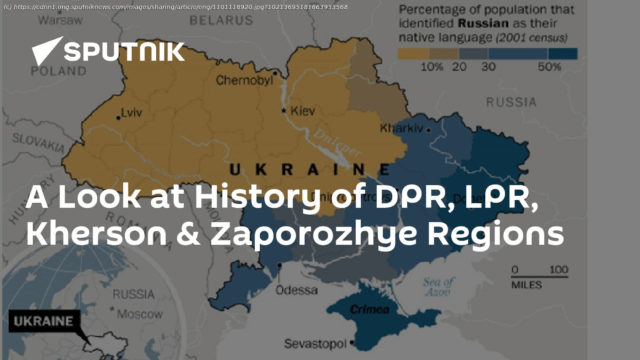The Donetsk and Lugansk People’s Republics, which proclaimed their independence from Ukraine in 2014, announced their plans to hold referendums to join Russia. 23.09.2022, Sputnik International
Referendums on accession to Russia in the Donetsk and Lugansk People’s Republics (DPR and LPR), as well as Russian-controlled parts of the regions of Kherson and Zaporozhye are to run from 23 to 27 September.On February 21, Russia recognized the DPR and LPR as independent states. Russian president Vladimir Putin announced the start of a special military operation in Ukraine on February 24 in response to calls for help from the two breakaway republics, whose predominantly Russian-speaking population faced intensifying attacks on the part of Kiev. The nationalist regime that came to power on the back of a West-backed coup in 2014 had killed thousands of civilians over the course of eight years, with all attempts to resolve the conflict peacefully, promoted by Russia, foiled by Ukrainian officials.In the course of the operation, significant areas of the DPR and the entire territory of the LPR were liberated. Russian forces also took control of the Kherson region and the Azov part of the Zaporozhye region, with new administrations formed in both regions. Since then, Russian TV channels and radio stations have begun broadcasting there, and trade and transport links with Crimea are being restored.The DPR and LPR announced their plans on September 20 to simultaneously hold referendums to join Russia following the respective requests from their Civil Councils. The Russian-controlled parts of the regions of Zaporozhye and Kherson also announced plans for holding similar referendums, hoping that the initiative would result in securing the territories of the region, opening “new opportunities for a return to a full-fledged peaceful life.”According to Volodymyr Rogov, a member of the civic council of the Zaporozhye region, the area of the liberated territories where the referendums will be held is about 113,000 square kilometers. After the accession referendums held by the LPR, DPR, Kherson and Zaporozhye regions, the population of Russia could potentially increase by five to six million people.Here is a detailed look at the areas, which are determining their future.Donetsk People’s Republic (DNR)The Donetsk People’s Republic (within the borders of the Donetsk region) is situated in the south of the East European Plain. Washed by the Sea of Azov from the south, it borders on Ukraine (Dnipropetrovsk, Zaporozhye and Kharkov regions), Russia and the Lugansk People’s Republic.The area of the territory (within the borders of the Donetsk region) is 26.5 thousand square kilometers. According to the Main Department of Statistics of the DPR, as of March 1, 2022, the population is estimated to be about 2.198 million people. The DPR is a presidential republic, with Donetsk, Makeevka, Gorlovka its three largest cities.The city of Donetsk grew from a mining settlement in the early 1860s. It received city status in May 1917, and at the end of that year, Soviet power was established in the city during the revolution.From January / February — March 1918, Donetsk was part of the Donetsk-Krivoy Rog Soviet Republic within the Russian Soviet Federative Socialist Republic (RSFSR). At the second All-Ukrainian Congress of Soviets on March 17-19, 1918, it was incorporated within the Ukrainian Soviet Republic. After the signing of the Brest-Litovsk Treaty on March 3, 1918, between the new Bolshevik government of Russia and the Central Powers (German Empire, Austria-Hungary, Bulgaria, and the Ottoman Empire), that ended Russia’s participation in World War I, Donetsk was occupied by German troops at the end of April 1918. Until the end of 1918 the city remained part of the Ukrainian state of Hetman Pavlo Skoropadsky. In December 1919, during an offensive launched by the Red Army, Soviet power was restored in Donetsk.From the end of the 19th century, the region experienced an industrial boom, with metallurgical and machine-building plants, railways, and mines built. On July 2, 1932, the Donetsk region was formed as part of the Ukrainian SSR. On June 3, 1938, it was split into the Stalin and Voroshilovgrad (now Lugansk) regions.During World War II (The Great Patriotic War), on October 20, 1941, Donetsk was occupied by German troops. 92,000 people are estimated to have died in the three concentration camps set up by the fascists in the city and surrounding areas. On September 8, 1943, Donetsk was liberated by Soviet troops during the Donbass offensive operation.After the collapse of the USSR in 1991, the territory that is now the Donetsk People’s Republic found itself a part of Ukraine.However, in 2014, protests began to erupt in the southeastern regions as people became increasingly dissatisfied with the new leadership of Ukraine, after then-President Viktor Yanukovych was overthrown in a coup d’etat orchestrated by Washington and Brussels, giving rise to the Ukrainian crisis and sparking a civil war in Donbass.On April 13, 2014, Acting President of Ukraine Oleksandr Turchynov announced a «large-scale anti-terrorist operation» involving the army against the predominantly Russian-speaking south-eastern regions.On May 11, 2014, a referendum on self-determination was held in the Donetsk region amid fears that new nationalist politicians would infringe on their rights to freely use the Russian language.






